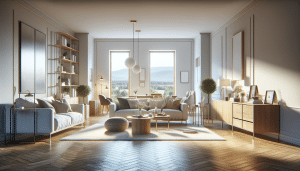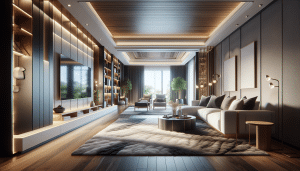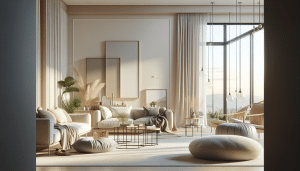You Can Elevate Your Living Room With Minimalist Decor
Jessica White September 27, 2025
Minimalist decor is transforming living spaces everywhere. This guide explores how anyone can refresh a living room, maximize comfort, and create a stylish sanctuary with simple design elements, affordable furniture choices, and functional accessories. Uncover practical strategies to combine beauty and function while reducing clutter for a more intentional, serene lifestyle.
Understanding Minimalist Decor Principles
Minimalist decor is based on the idea that less can truly be more. By choosing a clean palette and removing excess, the focus shifts to what matters most in your living room. This approach creates open spaces that promote relaxation and clarity. When you enter a minimalist environment, you instantly notice an airy feeling. Minimalist living rooms use neutral colors and simple shapes to guide where the eye should go and maintain an uncluttered visual field. Every piece—sofa, table, art—carries meaning, providing both beauty and utility without unnecessary distraction.
Bringing minimalist decor into your home doesn’t require a complete overhaul. Begin with what’s already in your space. Remove or donate items that don’t serve a purpose or spark positive feelings. This strategy isn’t just about having fewer things—it’s about carefully curating those you keep. Modern homes with minimalist design often rely on elegant storage solutions, such as hidden drawers or multi-use furniture, to keep everyday essentials organized without cluttering up visible surfaces. It’s a sustainable way to decorate while keeping your home feeling fresh and welcoming.
Psychological studies suggest that a minimalist environment can contribute to mental wellness. When personal spaces are less cluttered, stress levels can decrease, and relaxation becomes more attainable (Source: https://www.apa.org/news/press/releases/stress/2015/impact). This is part of why minimalist decor is gaining so much popularity. The style’s understated elegance allows for easy updates—simply rotating a few accessories or seasonal plants is enough to keep the living room feeling new. Over time, living with less becomes an enjoyable, mindful practice, encouraging a deliberate approach to every item brought into the home.
Selecting Minimalist Furniture
The foundation of a minimalist living room is quality, functional furniture. Choose pieces that serve more than one purpose when possible. For example, a coffee table with built-in storage or sofas that can double as guest beds maximize both form and function. Neutral tones and simple silhouettes work best—avoid ornate patterns or complex shapes. This ensures furniture fades into the overall harmony of the space rather than overwhelming it. Streamlining the furniture in your living room can make it look—and feel—significantly larger and more open to movement.
Minimalist seating should prioritize comfort without excess. Sofas with straight lines, chairs in earth-toned fabrics, and light wooden frames bring warmth without drama. Keeping the palette subdued can make the space feel cohesive, but adding a single accent chair or textured cushion allows for gentle contrast. This technique creates visual interest while adhering to the less-is-more philosophy. Many minimalist homes combine natural materials—wood, cotton, and linen—with metal elements for subtle modern flair.
Flexibility matters in minimalist decor. Choose sectional sofas that can be rearranged to suit different gatherings or wall-mounted shelves that adapt as collections grow. Multi-purpose furniture is especially valuable for those in apartments or smaller houses, ensuring you have the storage you need without cluttering up the floor. This efficient approach doesn’t just look great—it also keeps costs down by reducing the need for extra items. Investing in a few well-made essentials is an effective way to blend style with practicality (Source: https://www.houzz.com/magazine/minimalist-living-room-design-ideas).
Using Color and Texture for Impact
A minimalist living room is often defined by its subtle color palette. Whites, grays, and beiges set a peaceful tone. However, this doesn’t mean the room has to feel cold or impersonal. Introduce a few carefully chosen accent colors—perhaps a forest green plant, a navy blue throw, or gentle blush accessories—to warm up the space and reflect your personality. This balance can be achieved with artwork, textiles, or even decorative books on a side table.
Texture plays a powerful role in minimalist decor, providing the tactile richness that neutral color schemes sometimes lack. Soft wool rugs, nubby cotton throws, and smooth ceramic vases bring depth and comfort to a room. Mixing textures keeps the design engaging without relying on loud colors or busy patterns. Layering materials thoughtfully, such as a leather ottoman with a linen pillow, allows you to tailor your environment to the seasons and your changing tastes.
Lighting can further accentuate color and texture. Aim for plenty of natural light during the day and soft, warm table or floor lamps in the evening. Mirrors can amplify daylight, making even small rooms appear more spacious. Adjustable blinds or sheer curtains provide control without cluttering the windows. When combined, these design tips enable you to achieve a minimalist living room that remains lively and inviting, not sterile or sparse (Source: https://www.bhg.com/room-decorating/living-room/basics/minimalist-living-room-decor-ideas/).
Organizing and Decluttering for Calm
True minimalism isn’t just a style—it’s a lifestyle change. Regular decluttering is the key. Begin by sorting your items into what is used or loved and what is simply taking up space. Give unwanted objects a new home by donating or selling them. Open shelving, baskets, and modular storage can help display the things you cherish while keeping clutter out of sight. Consistent organization forms the backbone of minimalist living, making everyday cleaning and maintenance much simpler.
Paperwork, cords, and miscellaneous knick-knacks often build up in living rooms. Investing in cable organizers, filing solutions, or even digitalizing documents is one way to maintain the streamlined look. Minimalist households often designate a single decorative tray or box for remotes, keys, and other daily-use items. This keeps surfaces clear and visually neat. Over time, these habits become second nature, freeing you from constant tidying and helping the space stay photo-ready day after day.
Mental wellbeing can improve when clutter is controlled, as supported by research from leading lifestyle organizations (Source: https://www.nap.edu/read/25331/chapter/4). Many people report feeling lighter and more relaxed once their living space matches their intentions. Building routines—such as a five-minute reset in the evening—ensures that clutter never becomes overwhelming. The act of simplifying what you own and how it’s stored can gradually shift one’s mindset from accumulation to appreciation.
Accessorizing with Intention
Minimalist style doesn’t require abandoning all decoration. Instead, it places value on each accessory. Select a few impactful artworks, a well-made vase, or a meaningful sculpture. Arrange these objects so each has purpose and enough space to stand out. Even functional items, like throw blankets or storage baskets, can be beautiful. Carefully chosen accessories add character, tell a story, and turn a room from merely clean to truly curated.
Live plants, whether leafy ferns or hardy succulents, are a cornerstone of minimalist interiors. Not only do they purify air, but they also bring energy and life into the living room without adding clutter. Choose planters that are simple in design and echo the color scheme of the room. A single large plant in a bare corner can become an impressive focal point without overwhelming the space or requiring extensive care.
Books, candles, and textiles offer easy seasonal changes without complicating the room’s overall composition. Switch pillow covers and throws as seasons shift for a refresh that remains consistent with minimalist principles. Art can also be rotated, keeping the daily atmosphere dynamic. Intentional accessorizing is about creating joy with less—highlighting what is meaningful, not what is merely decorative (Source: https://www.housebeautiful.com/room-decorating/living-family-rooms/g34785815/minimalist-living-room-ideas/).
Maintaining the Minimalist Lifestyle
Minimalism offers long-term satisfaction only if the lifestyle is maintained. Set regular intervals—perhaps once per quarter—to review your living room. Move on any items that no longer serve your daily life or personal growth. Remember, even useful objects eventually lose their place. Refreshing your space seasonally can keep things interesting and allow new decor to shine without buying in excess.
Communication with others in your household is essential. Agree on what minimalism means for your home and set shared organizational goals. This prevents the accumulation of unnecessary items and ensures the living room remains a collective sanctuary. Even family members with different tastes can contribute by selecting mutually appreciated items that blend in seamlessly. The result? A living room that reflects everyone’s sense of peace and belonging.
Over time, practicing restraint with new purchases becomes second nature. Minimalist living rooms evolve as habits shift from consumerism to conscious curation. You might find that focusing on experiences—like gathering with friends or reading together—matters more than constantly upgrading decor. This philosophy supports both emotional fulfillment and practical living (Source: https://www.psychologytoday.com/us/blog/the-moment-youth/201312/the-benefits-living-simply), ensuring your living room remains a peaceful retreat for years to come.
References
1. American Psychological Association. (2015). Stress in America Survey. Retrieved from https://www.apa.org/news/press/releases/stress/2015/impact
2. Houzz. (n.d.). Minimalist Living Room Design Ideas. Retrieved from https://www.houzz.com/magazine/minimalist-living-room-design-ideas
3. Better Homes & Gardens. (n.d.). Minimalist Living Room Decor Ideas. Retrieved from https://www.bhg.com/room-decorating/living-room/basics/minimalist-living-room-decor-ideas/
4. National Academies of Sciences, Engineering, and Medicine. (2019). The Importance of Decluttering. Retrieved from https://www.nap.edu/read/25331/chapter/4
5. House Beautiful. (2021). Minimalist Living Room Ideas. Retrieved from https://www.housebeautiful.com/room-decorating/living-family-rooms/g34785815/minimalist-living-room-ideas/
6. Psychology Today. (2013). The Benefits of Living Simply. Retrieved from https://www.psychologytoday.com/us/blog/the-moment-youth/201312/the-benefits-living-simply








